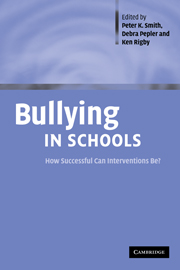Book contents
- Frontmatter
- Contents
- List of figures
- List of tables
- Notes on contributors
- Preface
- 1 Working to prevent school bullying: key issues
- 2 The Olweus Bullying Prevention Programme: design and implementation issues and a new national initiative in Norway
- 3 Is the direct approach to reducing bullying always the best?
- 4 Implementation of the Olweus Bullying Prevention programme in the Southeastern United States
- 5 Prevention of bullying in German schools: an evaluation of an anti-bullying approach
- 6 England: the Sheffield project
- 7 Making a difference in bullying: evaluation of a systemic school-based programme in Canada
- 8 Interventions against bullying in Flemish Schools: programme development and evaluation
- 9 SAVE model: an anti-bullying intervention in Spain
- 10 Australia: the Friendly Schools project
- 11 The Expect Respect project: preventing bullying and sexual harassment in US elementary schools
- 12 A follow-up survey of anti-bullying interventions in the comprehensive schools of Kempele in 1990–98
- 13 Targeting the group as a whole: the Finnish anti-bullying intervention
- 14 Ireland: the Donegal Primary Schools' anti-bullying project
- 15 Bernese programme against victimisation in kindergarten and elementary school
- 16 Looking back and looking forward: implications for making interventions work effectively
- Author index
- Subject index
- References
9 - SAVE model: an anti-bullying intervention in Spain
Published online by Cambridge University Press: 02 December 2009
- Frontmatter
- Contents
- List of figures
- List of tables
- Notes on contributors
- Preface
- 1 Working to prevent school bullying: key issues
- 2 The Olweus Bullying Prevention Programme: design and implementation issues and a new national initiative in Norway
- 3 Is the direct approach to reducing bullying always the best?
- 4 Implementation of the Olweus Bullying Prevention programme in the Southeastern United States
- 5 Prevention of bullying in German schools: an evaluation of an anti-bullying approach
- 6 England: the Sheffield project
- 7 Making a difference in bullying: evaluation of a systemic school-based programme in Canada
- 8 Interventions against bullying in Flemish Schools: programme development and evaluation
- 9 SAVE model: an anti-bullying intervention in Spain
- 10 Australia: the Friendly Schools project
- 11 The Expect Respect project: preventing bullying and sexual harassment in US elementary schools
- 12 A follow-up survey of anti-bullying interventions in the comprehensive schools of Kempele in 1990–98
- 13 Targeting the group as a whole: the Finnish anti-bullying intervention
- 14 Ireland: the Donegal Primary Schools' anti-bullying project
- 15 Bernese programme against victimisation in kindergarten and elementary school
- 16 Looking back and looking forward: implications for making interventions work effectively
- Author index
- Subject index
- References
Summary
Impetus for the intervention, early stages of planning, and funding
The first thing we should say about educational programmes against bullying in Spain is that, in the beginning, they ran up against the absence of information about the nature of bullying in our culture. Spanish schools, which are mainly public, have developed a very academic educational tradition that has left the aspects of social and emotional development to one side. They have taken little account of interpersonal relationships and the problems that arise within them (including bullying). Teachers were trained to focus their work on the teaching of basic disciplines, such as languages, sciences, or mathematics, within the compulsory education period from 6 to 14 years. As a result, neither our teachers nor our society had been sensitive to the interpersonal problems that we now recognise in our schools. In fact, the word bullying still does not have an accepted translation in our language. This has been one of the most serious problems that we have encountered: the need to explain to teachers and students what constitutes this type of violence, which some students can exercise over others. However, in recent years we have been attempting to develop a global education where socio-emotional aspects and concern for the world of interpersonal relationships have a place, even though this process is still unfinished.
- Type
- Chapter
- Information
- Bullying in SchoolsHow Successful Can Interventions Be?, pp. 167 - 186Publisher: Cambridge University PressPrint publication year: 2004
References
- 29
- Cited by

